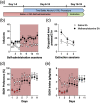Methamphetamine self-administration reduces alcohol consumption and preference in alcohol-preferring P rats
- PMID: 27860181
- PMCID: PMC5811924
- DOI: 10.1111/adb.12476
Methamphetamine self-administration reduces alcohol consumption and preference in alcohol-preferring P rats
Abstract
Subclinical levels of polysubstance use are a prevalent and understudied phenomenon. Alcohol is a substance commonly co-used with other substances of other drug classes. These studies sought to determine the consumption effects of combining alcohol drinking and methamphetamine (MA) self-administration. Male alcohol-preferring P rats had continuous access to a two-bottle alcohol drinking procedure in the home cage. Control rats remained alcohol naïve. Rats were also surgically implanted with intra-jugular catheters and trained to self-administer saline (control) or MA in daily 2-hour sessions. We first measured the acquisition and maintenance of MA intake in alcohol-consuming or control rats. MA intake was initially enhanced by alcohol consumption on a fixed ratio 1 schedule of reinforcement, but this effect did not prevail as the difficulty of the schedule (FR5 and progressive ratio) was increased. We next measured both alcohol consumption and preference before, during and after MA (or saline) self-administration. MA self-administration significantly reduced alcohol intake and preference ratios, a robust effect that persisted across several experimental variations. Interestingly, alcohol consumption rebounded following the cessation of MA self-administration. The effects of MA self-administration were specific to alcohol intake because it did not alter total fluid consumption or consumption of sucrose. MA self-administration did not impact blood-alcohol concentrations or alcohol-induced loss of righting reflex suggesting no effect of MA intake on the alcohol metabolism or sensitivity. Together, the results suggest that MA intake disrupts alcohol consumption and preferences but not the reverse in alcohol-preferring P rats.
Keywords: ethanol; polydrug use; psychostimulant.
© 2016 The Authors.Addiction Biology published by John Wiley & Sons Ltd on behalf of Society for the Study of Addiction.
Figures








Similar articles
-
Long-Evans rats acquire operant self-administration of 20% ethanol without sucrose fading.Neuropsychopharmacology. 2010 Jun;35(7):1453-63. doi: 10.1038/npp.2010.15. Epub 2010 Mar 3. Neuropsychopharmacology. 2010. PMID: 20200505 Free PMC article.
-
Effects of alcohol and saccharin deprivations on concurrent ethanol and saccharin operant self-administration by alcohol-preferring (P) rats.Alcohol. 2008 Jun;42(4):277-84. doi: 10.1016/j.alcohol.2008.01.011. Epub 2008 Apr 8. Alcohol. 2008. PMID: 18400451 Free PMC article.
-
Varenicline decreases nicotine but not alcohol self-administration in genetically selected Marchigian Sardinian alcohol-preferring (msP) rats.Drug Alcohol Depend. 2015 Nov 1;156:126-132. doi: 10.1016/j.drugalcdep.2015.09.002. Epub 2015 Sep 8. Drug Alcohol Depend. 2015. PMID: 26383997 Free PMC article.
-
Intravenous self-administration of alcohol in rats-problems with translation to humans.Addict Biol. 2017 Nov;22(6):1665-1681. doi: 10.1111/adb.12429. Epub 2016 Aug 2. Addict Biol. 2017. PMID: 27480572 Free PMC article. Review.
-
Timing Eclipses Amount: The Critical Importance of Intermittency in Alcohol Exposure Effects.Alcohol Clin Exp Res. 2020 Apr;44(4):806-813. doi: 10.1111/acer.14307. Epub 2020 Mar 26. Alcohol Clin Exp Res. 2020. PMID: 32056231 Free PMC article. Review.
Cited by
-
Effect of Modulation of the Astrocytic Glutamate Transporters' Expression on Cocaine-Induced Reinstatement in Male P Rats Exposed to Ethanol.Alcohol Alcohol. 2021 Feb 24;56(2):210-219. doi: 10.1093/alcalc/agaa104. Alcohol Alcohol. 2021. PMID: 33063090 Free PMC article.
-
Persistent effect of withdrawal from intravenous methamphetamine self-administration on brain activation and behavioral economic indices involving an effort cost.Neuropharmacology. 2018 Sep 15;140:130-138. doi: 10.1016/j.neuropharm.2018.07.023. Epub 2018 Jul 24. Neuropharmacology. 2018. PMID: 30053443 Free PMC article.
-
The effect of concurrent access to alcohol and oxycodone on self-administration and reinstatement in rats.Psychopharmacology (Berl). 2022 Oct;239(10):3277-3286. doi: 10.1007/s00213-022-06210-9. Epub 2022 Aug 16. Psychopharmacology (Berl). 2022. PMID: 35972517
-
Gold Nanoparticles (AuNPs) Coadministered with a β-Blocker Prevent Liver Fibrosis Caused by Ethanol and Methamphetamine in Rats by Downregulating the Expression of M2 Macrophages.ACS Omega. 2025 Apr 8;10(15):14924-14939. doi: 10.1021/acsomega.4c10118. eCollection 2025 Apr 22. ACS Omega. 2025. PMID: 40290979 Free PMC article.
-
Implication of Nanoparticles to Combat Chronic Liver and Kidney Diseases: Progress and Perspectives.Biomolecules. 2022 Sep 21;12(10):1337. doi: 10.3390/biom12101337. Biomolecules. 2022. PMID: 36291548 Free PMC article. Review.
References
-
- Brecht ML, Huang D, Evans E, Hser YI (2008) Polydrug use and implications for longitudinal research: ten‐year trajectories for heroin, cocaine, and methamphetamine users. Drug Alcohol Depend 96:193–201. DOI: 10.1016/j.drugalcdep.2008.01.021. - DOI - PMC - PubMed
-
- Bujarski S, Roche DJO, Lunny K, et al (2014) The relationship between methamphetamine and alcohol use in a community sample of methamphetamine users. Drug Alcohol Depend 142:127–132. DOI: 10.1016/j.drugalcdep.2014.06.004. - DOI - PMC - PubMed
-
- Cagniard B, Murphy NP (2009) Taste reactivity and its modulation by morphine and methamphetamine in C57BL/6 and DBA/2 mice. Physiol Behav 96:412–420. DOI: 10.1016/j.physbeh.2008.11.010. - DOI - PubMed
-
- Coffin PO, Galea S, Ahern J, et al (2003) Opiates, cocaine and alcohol combinations in accidental drug overdose deaths in New York City, 1990–98. Addict Abingdon Engl 98:739–747. - PubMed
-
- Dyr W, McBride WJ, Lumeng L, et al (1993) Effects of D1 and D2 dopamine receptor agents on ethanol consumption in the high‐alcohol‐drinking (HAD) line of rats. Alcohol 10:207–212. - PubMed
Publication types
MeSH terms
Substances
Grants and funding
LinkOut - more resources
Full Text Sources
Other Literature Sources
Medical

